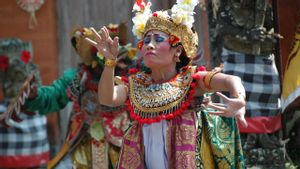
YOGYAKARTA - The ogoh-ogoh Parade is one of the processions in Nyepi Day in Bali. Hindus on the Island of the Gods will hold a vandalization or procession of ogoh-ogoh one day before Nyepi. After being brought around the village, this ogoh-ogoh statue was then burned.
This year's Nyepi Day falls on Monday 11 March 2024. Hindus in the country carry out various rituals starting from before Nyepi celebration day. One of the interesting rituals is the ogoh-ogoh parade which was then burned.
The ogoh-ogoh statue that is paraded around the village is in the form of a bhuta when it is a giant. The procession is carried out with the accompaniment of gamelan and torch sound. This ogoh-ogoh burning ritual has a deep meaning for Hindus.
The crackers or ogoh-ogoh parade have the meaning of being Bhuta Kala refugees from home, yard, and the surrounding environment. This giant Bhuta statue is a manifestation of bad properties for Hindu Nusantara's trust.
The ogoh-ogoh statue is visualized in the form of a large giant, scary face, and has long nails. These ogoh-ogoh are burned as symbols to destroy Bhuta Kala symbol all forms of evil on earth and human ill-fatedness.
It is said that the figure of Bhuta Kala began because Bhatara siwa sent his 4 sons, namely the Korsika, the Garga, the Maitri, and the Kurusya to create the universe. But they failed to carry out their duties so Bhatara Siwa was angry. Bhatara Siwa then condemned his children as Bhuta Kala.
The fusion of evil and evil is also a reflection for humans. When the ogoh-ogoh is burned, then we humans must also burn or destroy all evil in our hearts and minds.
The drafting ritual can be called an attempt to neutralize or clean up the bad before Hindus celebrate Nyepi Day. At the time of Nyepi Day Hindus will stay at home with silence and undergo Catur Brata Penyepian.
The burning of ogoh-ogoh became one of the mandatory rituals for Hindus during Nyepi Day. Before doing the ogoh-ogoh procession, the procession began with the Tawar Agung Kesanga ceremony. Then the ogoh-ogoh parade was only held in the afternoon or sandhyakala until the evening after carrying out the Mecaru ceremony at home.
The ogoh-ogoh or ganging parades are usually carried out by youths from each Sekaa Teruna Teruni (STT) of each traditional banjar. The ogoh-ogoh statue is paraded around the village accompanied by a gamelan accompaniment. In addition, participants will also carry torchs to accompany the ogoh-ogoh parade.
관련 항목:
The ogoh-ogoh Parade is a hereditary ritual among the Hindus of the archipelago which has been carried out for a long time. Reporting from the official website of Sangeh Village, Bandung Regency, the new ogoh-ogoh procession has expanded as a series of Nyepi celebrations in Bali since the 1980s.
Since now, Hindus in Denpasar have started to make ogoh-ogoh to be paraded around the village. This tradition then expanded even more when ogoh-ogoh was included in the Bali XII Arts Festival.
At first these ogoh-ogoh were only made from wooden frames and bamboo covered with paper. Over time, local people are increasingly creative in making ogoh-ogoh following the times. The ogoh-ogoh statue is then made with an iron and bamboo frame that is woven and wrapped in styrofoam.
Such is the review of the ritual of burning ogoh-ogoh and its meaning. In addition to having a special meaning for Hindus, this ogoh-ogoh parade ritual is also a special attraction in the eyes of tourists visiting Bali. Also read also the Bali Police focus on securing the ogoh-ogoh parade.
Stay up to date with the latest domestic and other overseas news on VOI. We present the latest and most updated nationally and internationally.
The English, Chinese, Japanese, Arabic, and French versions are automatically generated by the AI. So there may still be inaccuracies in translating, please always see Indonesian as our main language. (system supported by DigitalSiber.id)















